Sneezing is common to all humans and also occurs in most other mammals and in birds and reptiles. But what is it for? In mammals it seems to be a protective reflex designed to clear the nose of bacteria and viruses, but it may also have other health roles we don’t yet understand.
A sneeze (or sternutation, if you prefer the posh medical term) involves facial, pectoral and abdominal muscles working together to expel air rapidly from the lungs through the nose and mouth. When the brain’s “sneeze centre” is triggered, signals are sent to close the throat, eyes and mouth. Then the chest muscles strongly contract, the throat muscles relax and air is forced out of the mouth and nose at about 100mph — accompanied by saliva and mucus and up to 100,000 germs.
The usual stimulus of sneezing is irritation of the nasal mucosa, which causes a signal to zoom to the brain via the trigeminal nerve. But it also has a variety of alternative triggers, possibly because strong stimulation of other parts of the parasympathetic nervous system may spark the sneeze reflex through an overflow effect on nasal nerves. This is probably why sneezing often accompanies eyebrow-plucking.
In some unlucky people, a full stomach after a large meal can bring on uncontrollable bouts of sneezing. This inherited condition has been termed snatiation — a crass portmanteau of “sneeze” and “satiation”. (Even more oafish is a dreadfully contrived backronym claiming that snatiation stands for Sneezing Non-controllably At a Time of Indulgence of the Appetite—a Trait Inherited and Ordained to be Named.)
Exercise may be also a catalyst of sneezing. In this case the reason may be that hyperventilation caused by over-exertion dries up the nose, which starts to drip, inducing a a sneeze.
And some people find themselves sneezing after sexual activity — perhaps not because of hyperventilation following vigorous exercise but again because of the complications of the parasympathetic nervous system.
One of the odder triggers of sneezing is sudden exposure to bright light. As with eyebrow-plucking, this may be a knock-on effect from stimulation of nerves connected with sight. The phenomenon has been given various names, including photic sneeze reflex, photoptarmosis, sun sneezing and ACHOO syndrome (from another contrived acronym, Autosomal dominant Compelling Helio-Ophthalmic Outburst syndrome).
Within a few seconds of exposure to bright light, ACHOO syndrome sufferers tend to experience two or three violent sneezes at intervals of a couple of seconds. Because the eyes naturally close during a sneeze, and because sneezing may affect one’s concentration, the syndrome has led to accidents when drivers emerge into sunlight at the end of a long tunnel.
Since this inherited condition appears to affect between one-sixth and one-third of people worldwide, it is not to be sneezed at (sorry!). Perhaps all drivers should be made aware of the accident risk.


